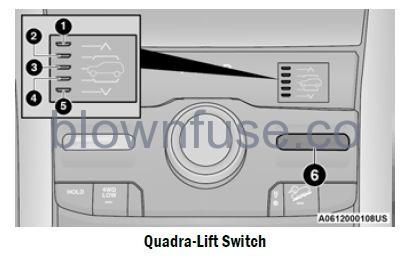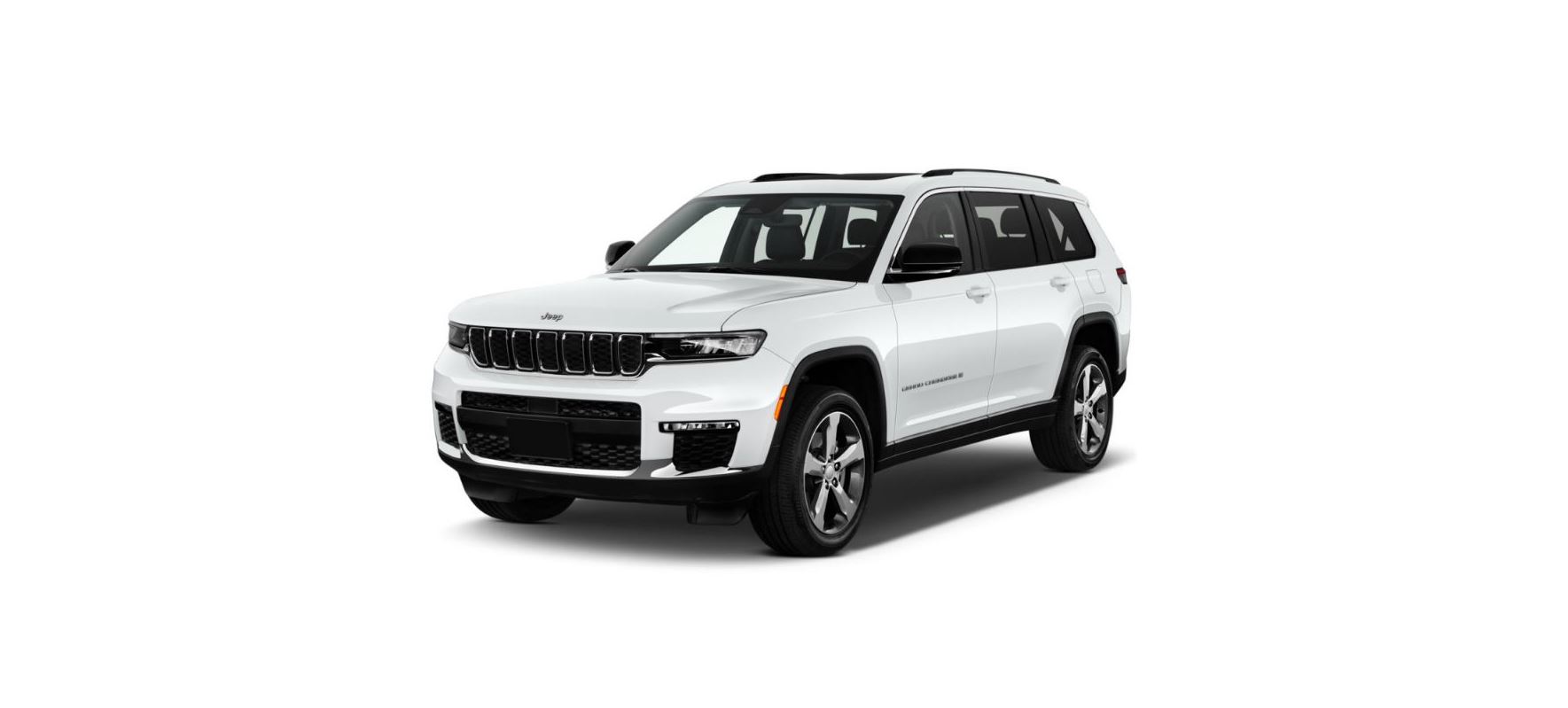2022 Jeep Grand Cherokee QUADRA-LIFT User Guide

QUADRA-LIFT
DESCRIPTION
The Quadra-Lift Air Suspension system provides full-time load-leveling capability along with the benefit of vehicle height adjustment by a toggle switch. The vehicle will automatically raise and lower the ride height to adapt to the appropriate driving conditions. At higher speeds, the vehicle will lower to an aerodynamic ride height and when operating in off-road modes, the vehicle will raise the ride height accordingly. The buttons near the terrain switch in the center console area can be used to set the preferred ride height to match the appropriate conditions.
- Quadra-Lift Switch
- Off-Road 2 Height Indicator Lamp (Customer Selectable)
- Off-Road 1 Height Indicator Lamp (Customer Selectable)
- Normal Ride Height Indicator Lamp (Customer Selectable)
- Aero Height Indicator Lamp
- (Customer Selectable)
- Entry/Exit Height Indicator Lamp (Customer Selectable)
- Toggle Switch
- Off-Road 2 (OR2) (Non-TrailHawk Raises the vehicle approximately 2.4 inches [60 mm])
- (TrailHawk Raises the vehicle approximately 3.0 inches 75 mm]) – This position is intended for off-roading use only where maximum ground clearance is required. To enter OR2, push the UP button twice from the NRH position or once from the OR1 position while the vehicle speed is below 20 mph (32 km/h). While in OR2, if the vehicle speed exceeds 25 mph (40 km/h) the vehicle height will be automatically lowered to OR1 page 200.
- Off-Road 1 (OR1) (Raises the vehicle approximately 1.6 inches [40 mm]) – This is the primary position for all off-road driving until OR2 is needed. Push the UP button once from the
- NRH position while the vehicle speed is below 38 mph (61 km/h). When in the OR1 position, if the vehicle speed remains between 40 mph
(64 km/h) and 50 mph (80 km/h) for greater than 20 seconds or if the vehicle speed exceeds 50 mph (80 km/h), the vehicle will be automatically lowered to NRH page 200.
- NRH position while the vehicle speed is below 38 mph (61 km/h). When in the OR1 position, if the vehicle speed remains between 40 mph
- Normal Ride Height (NRH) 0.0 inches (0 mm) – This is the standard position of the suspension and is meant for normal driving.
- Aero Height (Lowers the vehicle approximately -0.8 inches [-21 mm] Front and -1.0 inches [-25 mm] Rear) – This position provides improved aerodynamics by lowering the vehicle. The vehicle will automatically enter Aero when the vehicle speed remains between 62 mph (100 km/h) and 66 mph (106 km/h) for greater than 20 seconds or if the vehicle speed exceeds 66 mph (106 km/h). The vehicle will return to NRH from Aero if the vehicle speed remains between 30 mph (48 km/h) and 35 mph (56 km/h) for greater than 20 seconds or if the vehicle speed falls below 30 mph (48 km/h). The vehicle will enter Aero, regardless of vehicle speed if the vehicle is in SPORT mode.
- Entry/Exit Height (Lowers the vehicle approximately -1.8 inches [-46 mm] Front and -2.0 inches [-50 mm] Rear) – This position lowers the vehicle for easier passenger entry and exit as well as lowering the rear of the vehicle for easier loading and unloading of cargo. To enter Entry/Exit, push the DOWN button twice from NRH while the vehicle speed is below 6 mph (10 km/h). To exit Entry/Exit, push the UP button twice while in Entry/Exit or drive the vehicle over 6 mph (10 km/h).
NOTE
Automatic lowering of the vehicle into Entry/Exit can be enabled through the Uconnect Touch-screen Radio by selecting the “Auto Entry/Exit” setting. If this feature is enabled, the vehicle will only lower if the gear selector is in PARK, the terrain switch is in AUTO, the transfer case is in AUTO and the vehicle level is either in Normal or Aero Height. The vehicle will not automatically lower to Entry/Exit height if the air suspension level is in OR2 or OR1. If the vehicle is equipped with an Intrusion Theft Module (ITM), the lowering will be suppressed when the ignition is switched OFF and the door is open to prevent setting the alarm off. The Selec-Terrain system will automatically change the vehicle to the proper height based on the position of the Selec-Terrain switch. The height can be changed from the default Selec-Terrain setting by normal use of the air suspension buttons page 137.
The system requires that the engine be running for all changes. When lowering the vehicle all of the doors must be closed. If a door is opened at any time while the vehicle is lowering the change will not be completed until the open door(s) is/are closed. The Quadra-Lift Air Suspension system uses lifting and lowering pattern which keeps the headlights from incorrectly shining into oncoming traffic. When raising the vehicle, the rear of the vehicle will move up first and then the front. When lowering the vehicle, the front will move down first and then the rear. After the engine is turned off, it may be noticed that the air suspension system operates briefly; this is normal. The system is correcting the position of the vehicle to ensure a proper appearance. To assist with changing a spare tire, the Quadra-Lift Air Suspension system has a feature that allows the automatic leveling to be disabled page 204.
Default Ride Height
- Select Aero Height or Normal Ride Height as the default for all vehicle speeds and operation. This is the selected height that the suspension will level for speed changes (e.g. raising from Entry/Exit Height at speed, lowering from Off-Road Height at speed, etc.).
- Default ride height can be changed by manually adjusting the ride height switch to Normal Ride Height or Aero Height and staying in the selected height for 2.5 seconds. It will be stored as the default ride height and the height will be maintained until a new default ride height is selected.
If equipped with a touchscreen radio, all enabling/disabling of air suspension features must be done through the radio page 204.
WARNING
The air suspension system uses a high-pressure volume of air to operate the system. To avoid personal injury or damage to the system, see an authorized dealer for service.
AIR SUSPENSION MODES
The Air Suspension system has multiple modes to protect the system in unique situations:
Tire/Jack Mode
To assist with changing a spare tire, the air suspension system has a feature that allows the automatic leveling to be disabled page 204.
NOTE: This mode is intended to be enabled with the ignition on.
Auto Entry/Exit Mode
To assist in entering and exiting the vehicle, the air suspension system has a feature that automatically lowers the vehicle to Entry/Exit ride height page 204.
NOTE: This mode is intended to be enabled with the ignition on.
Transport Mode
To assist with flatbed towing, the air suspension system has a feature that will put the vehicle into Entry/Exit height and disable the automatic load leveling system page 204.
NOTE: This mode is intended to be enabled with the ignition on.
Suspension Display Messages Mode
The “Suspension Display Messages” setting allows you to only display suspension warnings on page 204.
NOTE: This mode is intended to be enabled with the ignition on.
Wheel Alignment Mode
Before performing a wheel alignment this mode must be enabled page 204.
NOTE: This mode is intended to be enabled with the ignition on. If equipped with a touchscreen radio, all enabling/disabling of air suspension features must be done through the radio page 204.
INSTRUMENT CLUSTER DISPLAY
MESSAGES
When the appropriate conditions exist, a message will appear in the instrument cluster page 99.
OPERATION
The indicator lamps 1 through 5 will illuminate to show the current position of the vehicle. Flashing indicator lamps will show a position that the system is working to achieve. When raising, if multiple indicator lamps are flashing while raising, the highest flashing indicator lamp is the position the system is working to achieve. When lowering, if multiple indicators are flashing while lowering, the lowest solid indicator lamp is the position the system is working to achieve. Toggle up once will move the suspension one position higher from the current position, assuming all conditions are met (i.e. ignition on, speed below the threshold, etc). Toggle up can be pushed multiple times. Each toggle up will raise the requested level by one position up to a maximum position of OR2 or the highest position allowed based on current conditions (i.e. vehicle speed, etc). Toggle down once will move the suspension one position lower from the current level, assuming all conditions are met (i.e. ignition on, doors closed, speed below the threshold, etc). Toggle down can be pushed multiple times. Each toggle down will lower the requested level by one position down to a minimum of Entry/Exit Height or the lowest position allowed based on current conditions (i.e. vehicle speed, etc.)
Automatic height changes will occur based on vehicle speed and the current vehicle height. The indicator lamps and instrument cluster display messages will operate the same for automatic changes and user-requested changes.
- Off-Road 2 (OR2) – Indicator lamps 1 through 5 will be illuminated.
- Off-Road 1 (OR1) – Indicator lamps 2 through 5 will be illuminated.
- Normal Ride Height (NRH) – Indicator lamps 3 through 5 will be illuminated.
- Aero Height– Indicator lamps 4 and 5 will be illuminated.
- Entry/Exit Height– Indicator lamp 5 will be illuminated.
- Transport Mode – Indicator lamp 5 will be illuminated. Driving above 3 mph (5 km/h) or selecting a setting in the radio will disable Transport Mode.
- Tire/Jack Mode – Indicator lamps 3 through 5 will be illuminated. Driving above 5 mph (8 km/h) or deselecting a setting in the radio will disable Tire/Jack Mode.
- Wheel Alignment Mode – Indicator lamps 3 through 5 will be illuminated. Driving above 5 mph (8 km/h) or deselecting a setting in the radio will disable Wheel Alignment Mode.

